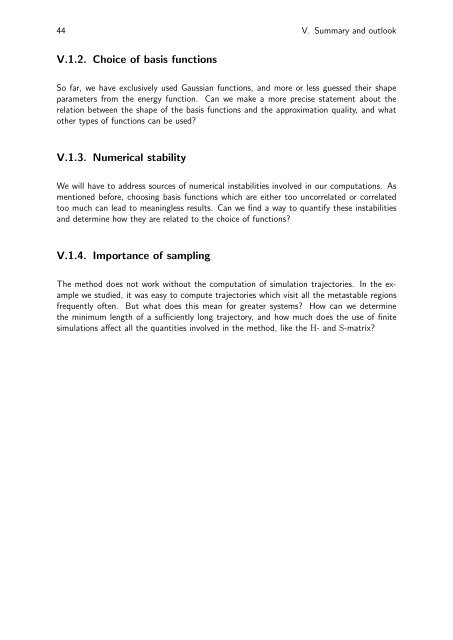Variational Principles in Conformation Dynamics - FU Berlin, FB MI
Variational Principles in Conformation Dynamics - FU Berlin, FB MI
Variational Principles in Conformation Dynamics - FU Berlin, FB MI
- No tags were found...
You also want an ePaper? Increase the reach of your titles
YUMPU automatically turns print PDFs into web optimized ePapers that Google loves.
44 V. Summary and outlookV.1.2. Choice of basis functionsSo far, we have exclusively used Gaussian functions, and more or less guessed their shapeparameters from the energy function. Can we make a more precise statement about therelation between the shape of the basis functions and the approximation quality, and whatother types of functions can be used?V.1.3. Numerical stabilityWe will have to address sources of numerical <strong>in</strong>stabilities <strong>in</strong>volved <strong>in</strong> our computations. Asmentioned before, choos<strong>in</strong>g basis functions which are either too uncorrelated or correlatedtoo much can lead to mean<strong>in</strong>gless results. Can we f<strong>in</strong>d a way to quantify these <strong>in</strong>stabilitiesand determ<strong>in</strong>e how they are related to the choice of functions?V.1.4. Importance of sampl<strong>in</strong>gThe method does not work without the computation of simulation trajectories. In the examplewe studied, it was easy to compute trajectories which visit all the metastable regionsfrequently often. But what does this mean for greater systems? How can we determ<strong>in</strong>ethe m<strong>in</strong>imum length of a sufficiently long trajectory, and how much does the use of f<strong>in</strong>itesimulations affect all the quantities <strong>in</strong>volved <strong>in</strong> the method, like the H- andS-matrix?









